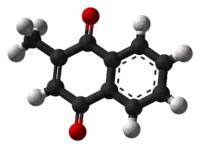メナジオン
メナジオン(Menadione)は合成ビタミンKであり、サプリメントとして用いられていた。1,4-ナフトキノンの2位をメチル基で置換した構造である[2]。
| メナジオン[1] | |
|---|---|
 | |
 | |
| |
別称
| |
| 識別情報 | |
| CAS登録番号 | 58-27-5 |
| PubChem | 4055 |
| ChemSpider | 3915 |
| UNII | 723JX6CXY5 |
| 日化辞番号 | J4.591H |
| DrugBank | DB00170 |
| KEGG | C05377 D02335 |
| ChEBI | |
| ChEMBL | CHEMBL590 |
| ATC分類 | B02BA02 |
| |
| |
| 特性 | |
| 化学式 | C11H8O2 |
| モル質量 | 172.18 g mol−1 |
| 外観 | 山吹色結晶 |
| 密度 | 1.225 g cm-3 |
| 融点 |
105–107 °C |
| 沸点 |
304.5 °C @ 760mmHg |
| 水への溶解度 | 不溶 |
| 危険性 | |
| 引火点 | 113.8 °C |
| 半数致死量 LD50 | 0.5 g/kg (マウス、経口) |
| 関連する物質 | |
| 関連物質 | 1,4-ナフトキノン メナジオール |
| 特記なき場合、データは常温 (25 °C)・常圧 (100 kPa) におけるものである。 | |
用語
3位の側鎖がないため、ビタミンKの全機能を持つわけではないが、ビタミンK3と呼ばれている[3]。アルキル化されることでビタミンK2(メナキノン)となることから、プロビタミンに分類するのが適当である。
メナフトン(menaphthone)としても知られる[4]。
用途
ビタミンKの前駆体ではあるが、先進国ではサプリメントとしては用いられない。発展途上国では入手可能な場合もある。グルコース6リン酸脱水素酵素欠損症患者に溶血性貧血・核黄疸・高ビリルビン血症などの副作用を起こし、大量摂取により健常な幼児にも同じような症状を起こす[5]。米国ではFDAによりサプリメントとしての使用が禁止されている。
だが多くの国では、家畜用の安価なビタミンK源として少用量で用いられている。先進国でもペットフードに添加されることがある。
低プロトロンビン血症の治療にも用いられる。
出典
- The Merck Index, 11th Edition, 5714
- Castro FA, Mariani D, Panek AD, Eleutherio EC, Pereira MD (2008). Fox, Debbie. ed. “Cytotoxicity Mechanism of Two Naphthoquinones (Menadione and Plumbagin) in Saccharomyces cerevisiae”. PLoS ONE 3 (12): e3999. doi:10.1371/journal.pone.0003999. PMC 2600608. PMID 19098979.
- Scott GK, Atsriku C, Kaminker P, et al (September 2005). “Vitamin K3 (menadione)-induced oncosis associated with keratin 8 phosphorylation and histone H3 arylation”. Mol. Pharmacol. 68 (3): 606–15. doi:10.1124/mol.105.013474. PMID 15939799.
- “Vitamin K”. 2009年3月18日閲覧。
- ビタミンK - 「健康食品」の安全性・有効性情報(国立健康・栄養研究所)
- J. S. MITCHELL , I. SIMON-REUSS (1947), “Combination of Some Effects of X-Radiation and a Synthetic Vitamin K Substitute”, Nature (160): 98-99, doi:10.1038/160098a0
- James M. Jamison, Jacques Gilloteaux, Henryk S. Taper and Jack L. Summers (2001). “Evaluation of the In Vitro and In Vivo Antitumor Activities of Vitamin C and K-3 Combinations against Human Prostate Cancer”. J. Nutr. 131 (1): 158S–160S. PMID 11208954.
- Tareen B, Summers JL, Jamison JM, Neal DR, McGuire K, Gerson L, Diokno A (2008). “A 12 Week, Open Label, Phase I/IIa Study Using Apatone® for the Treatment of Prostate Cancer Patients Who Have Failed Standard Therapy”. Int J Med Sci 5 (2): 62–67. PMC 2288789. PMID 18392145.
- R. Perez-Soler, Y. Ling, Y. Zou, S.R. Deitcher (2008). “Local Rescue of Skin Toxicities Secondary to Kinase Inhibitor (KI) Therapy with Topical Menadione”. Annals of Oncology.
- Tianhong Li and Roman Perez-Soler (2009). “Skin toxicities associated with epidermal growth factor receptor inhibitors”. Targeted Oncology 4 (2): 107–119. doi:10.1007/s11523-009-0114-0. PMID 19452131.
This article is issued from Wikipedia. The text is licensed under Creative Commons - Attribution - Sharealike. Additional terms may apply for the media files.